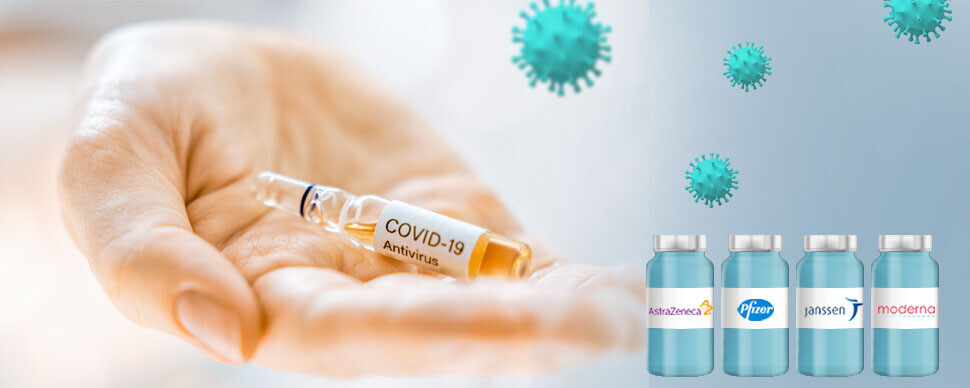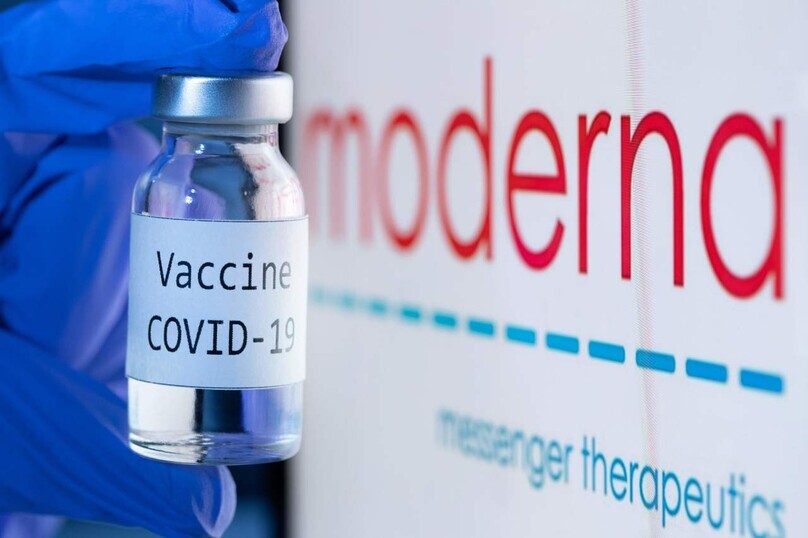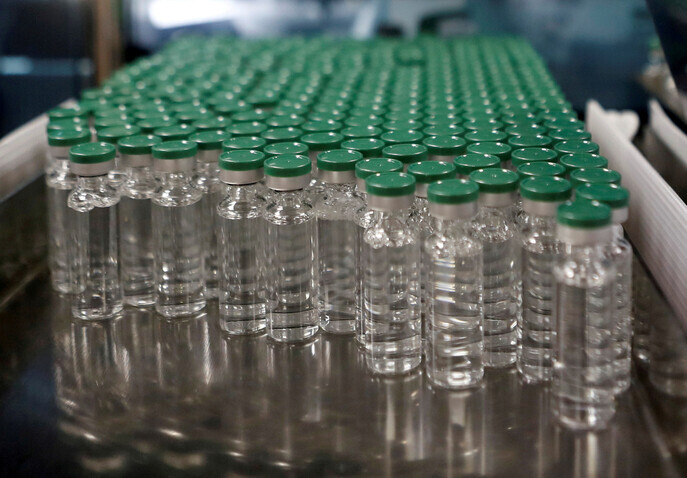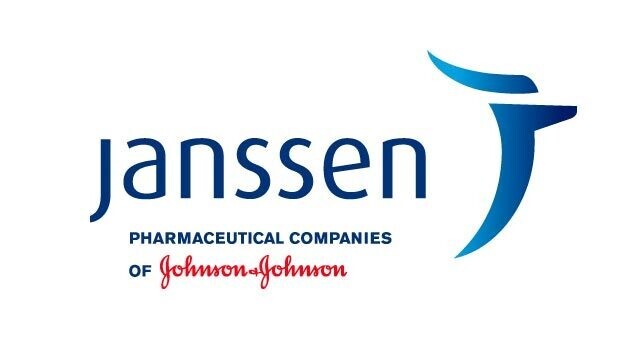hankyoreh
Links to other country sites 다른 나라 사이트 링크
[News analysis] A breakdown of the 4 vaccines that will be available in S. Korea

The South Korean government has signed supply contracts for COVID-19 vaccines from four global pharmaceutical firms. Despite variations in inoculation method, price and approval status, the four vaccines have one thing in common: they’re some of the world’s fastest, most stable, and most effective vaccine options.
Seoul has started making preparations for disseminating vaccines, which it believes could start as soon as the beginning of 2021. Meanwhile, the government plans to keep tabs on developments in the UK and other countries that have actually begun inoculation.

Jointly developed by US company Pfizer and German company BioNTech, this is the fastest vaccine to be developed. Inoculations began in the UK on Dec. 8, the first Western country to distribute the vaccine.
Pfizer’s vaccine was made with messenger RNA (mRNA), which had never been used before in vaccine development. The single-stranded mRNA plays a key role in manufacturing proteins by delivering DNA to cells. In this vaccine, mRNA is designed to create spike proteins similar to those on the surface of SARS-CoV-2, triggering an immune response that leads the body to produce antibodies.
Up until now, vaccines have been made of viral fragments that are inserted into the body to function as antigens that provoke an immune response. In contrast, the Pfizer vaccine inserts genetic code for making antigens, leading to the production of antibodies.
While this method does permit mass production, the virus is less stable because it uses genetic material, which is even tinier than viruses. As a result, the vaccine has to be kept at the super-cold temperature of -70 degrees Celsius during transportation and storage. The vaccine is also on the expensive side, costing US$19.5 per dose — two to five times the price of other vaccines — with each person needing two doses.
Pfizer’s vaccine is quite good at preventing infection. In the interim results of Phase 3 clinical trials, announced in Western countries on Nov. 9, the vaccine was 95% effective.
Pfizer’s vaccine trials proceeded as follows. A total of 43,000 people took part in Phase 3; half were administered the COVID-19 vaccine, and the other half, the control group, were administered a placebo (a saline solution with no vaccine).
After a certain period of time, the volunteers were tested for COVID-19. Among the 170 people who tested positive, 162 had received the placebo in the control group, while eight had received the actual vaccine. If the vaccine were ineffective, there should have been about 162 patients, rather than eight, in the vaccinated group as well. That is calculated as a vaccine efficacy of 94.5%.
Significantly, Pfizer said its vaccine is also effective among the elderly, with the vaccine being 94% effective among people aged 65 and above.

In terms of development speed, US-based Moderna has been in hot pursuit of Pfizer, releasing the results of its Phase 3 clinical trials on Nov. 16, just one week after Pfizer. And just like Pfizer, Moderna developed its vaccine using the mRNA approach. That makes transportation and storage more complicated and the vaccine the priciest of any available, ranging from US$25-37 per dose. Like Pfizer’s vaccine, Moderna’s also needs two doses to be effective. However, Moderna’s vaccine only has to be stored at -20 degrees Celsius, a less demanding requirement than Pfizer’s.
Moderna’s vaccine is quite effective. There were 30,000 volunteers in its Phase 3 clinical trials, with one group receiving the vaccine and one group receiving a placebo. A total of 95 volunteers contracted COVID-19, five from the vaccinated group and 90 from the placebo group. If the vaccine hadn’t been effective, there should have been about 90 patients, rather than five, in the vaccinated group. Thus, the vaccine can be calculated as being 94.5% effective.
The vaccines developed by Pfizer and Moderna will both cost more than US$20 per dose, and the need for high-performance refrigeration presents difficulties for transportation and storage. As a result, it’s unlikely that these vaccines could be widely distributed in low-income countries in Africa, South America, and Southeast Asia. South Korea is planning to receive 20 million vaccine doses (enough for 10 million people) from each of these two companies.
The vaccines are expected to begin arriving around February or March of next year, but the actual inoculation timeframe has yet to be determined. The government wants to stay flexible about that decision, which it will make after monitoring the spread of COVID-19 at home and the inoculation situation in other countries.

AstraZeneca/University of Oxford: stable and affordable
This vaccine is jointly developed by British company AstraZeneca and the University of Oxford, representing the third Western team to release the results of their Phase 3 clinical trials on Nov. 23. This vaccine was developed using the viral vector technique, which has been in use for decades. The vaccine is highly stable and easier to transport and store. It’s also the cheapest vaccine, costing US$4 per dose.
The vector used by the AstraZeneca virus is an adenovirus that causes colds in chimpanzees. The virus is inserted with genetic material that makes the spike protein from the SARS-CoV-2. When a vaccine made with this virus is injected into the human body, cells mistake it for a real virus, triggering an immune response.
Developed decades ago, the viral vector approach has been used to make vaccines for malaria, tuberculosis and Ebola. In short, the approach is known to be stable. Furthermore, AstraZeneca promised in July to distribute the vaccine at no margin, raising hopes that this could be an option for middle- and low-income countries.
In terms of efficacy, AstraZeneca’s vaccine is somewhat lower than Pfizer’s and Moderna’s. According to the Phase 3 clinical trial results released on Nov. 23, the vaccine was 70% effective.
But there were substantial differences in efficacy depending on the inoculation method, which has led AstraZeneca to plan another trial. The vaccine was found to be 90% effective in part of the experimental group that only received half of the first dose and 62% effective in the rest of the experimental group, which received the standard amount in both doses. Eyebrows were raised when AstraZeneca explained that this methodological variation had been accidental, rather than intentional.
The Lancet, a medical journal, printed a paper assessing AstraZeneca’s published results on Dec. 8. Researchers confirmed the vaccine’s efficacy and said it would also be effective at preventing asymptomatic infection. The vaccine was 59% effective against asymptomatic infection among those who only received half of the initial dose and 4% effective among those who received two standard doses. Pfizer and Moderna didn’t conduct separate analyses of vaccine efficacy against asymptomatic infection.

Janssen: slow but simple, only requiring a single dose
In contrast with the three vaccines mentioned above, Janssen hasn’t published the interim results for its Phase 3 clinical trials yet. While this vaccine’s development has fallen a little behind the others, Janssen is a subsidiary of Johnson & Johnson, the world’s largest pharmaceutical firm, and its Phase 3 trials consist of 60,000 volunteers, the most of any of these vaccine developers. That has primed hopes that Janssen’s efficacy results will be credible when they’re released. The vaccine is currently being reviewed by regulators in Canada and the EU.
Janssen’s vaccine uses the “viral vector” approach, just like AstraZeneca’s. The vaccine will be easy to transport and store and comes with a cheaper price tag, at US$10 per dose. Perhaps the vaccine’s greatest advantage is its simplicity: unlike the competition, a single dose is enough. Johnson & Johnson, parent company of Janssen, has publicly promised to distribute the vaccine at no margin for the duration of the COVID-19 pandemic.
By Choi Hyun-june, staff reporter
Please direct comments or questions to [english@hani.co.kr]

Editorial・opinion
![[Editorial] Penalties for airing allegations against Korea’s first lady endanger free press [Editorial] Penalties for airing allegations against Korea’s first lady endanger free press](https://flexible.img.hani.co.kr/flexible/normal/500/300/imgdb/original/2024/0502/1817146398095106.jpg) [Editorial] Penalties for airing allegations against Korea’s first lady endanger free press
[Editorial] Penalties for airing allegations against Korea’s first lady endanger free press![[Editorial] Yoon must halt procurement of SM-3 interceptor missiles [Editorial] Yoon must halt procurement of SM-3 interceptor missiles](https://flexible.img.hani.co.kr/flexible/normal/500/300/imgdb/child/2024/0501/17145495551605_1717145495195344.jpg) [Editorial] Yoon must halt procurement of SM-3 interceptor missiles
[Editorial] Yoon must halt procurement of SM-3 interceptor missiles- [Guest essay] Maybe Korea’s rapid population decline is an opportunity, not a crisis
- [Column] Can Yoon steer diplomacy with Russia, China back on track?
- [Column] Season 2 of special prosecutor probe may be coming to Korea soon
- [Column] Park Geun-hye déjà vu in Yoon Suk-yeol
- [Editorial] New weight of N. Korea’s nuclear threats makes dialogue all the more urgent
- [Guest essay] The real reason Korea’s new right wants to dub Rhee a founding father
- [Column] ‘Choson’: Is it time we start referring to N. Korea in its own terms?
- [Editorial] Japan’s rewriting of history with Korea has gone too far
Most viewed articles
- 1[Editorial] Penalties for airing allegations against Korea’s first lady endanger free press
- 260% of young Koreans see no need to have kids after marriage
- 3Months and months of overdue wages are pushing migrant workers in Korea into debt
- 4Bills for Itaewon crush inquiry, special counsel probe into Marine’s death pass National Assembly
- 51 in 3 S. Korean security experts support nuclear armament, CSIS finds
- 6[Guest essay] Maybe Korea’s rapid population decline is an opportunity, not a crisis
- 7[Reporter’s notebook] In Min’s world, she’s the artist — and NewJeans is her art
- 8[Editorial] Yoon must halt procurement of SM-3 interceptor missiles
- 9S. Korea discusses participation in defense development with AUKUS alliance
- 10Cracks found in containment building of UAE nuclear power plant built by S. Korean companies